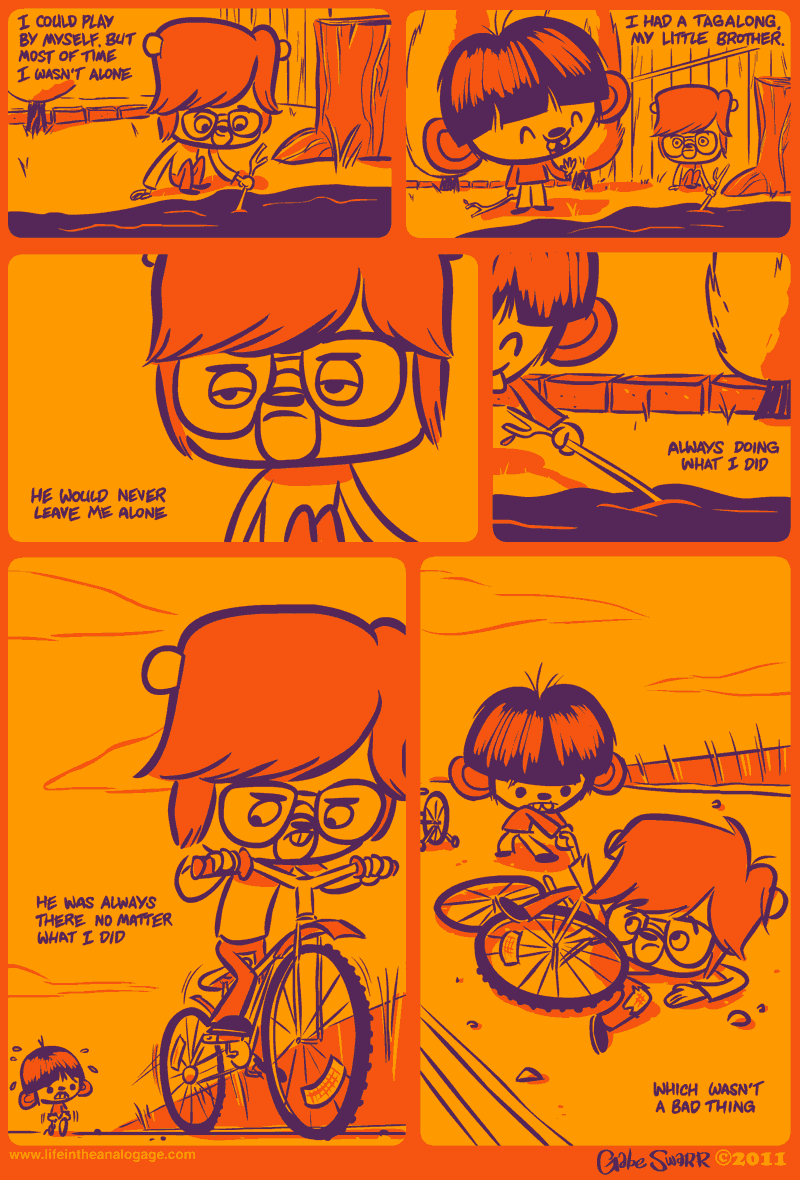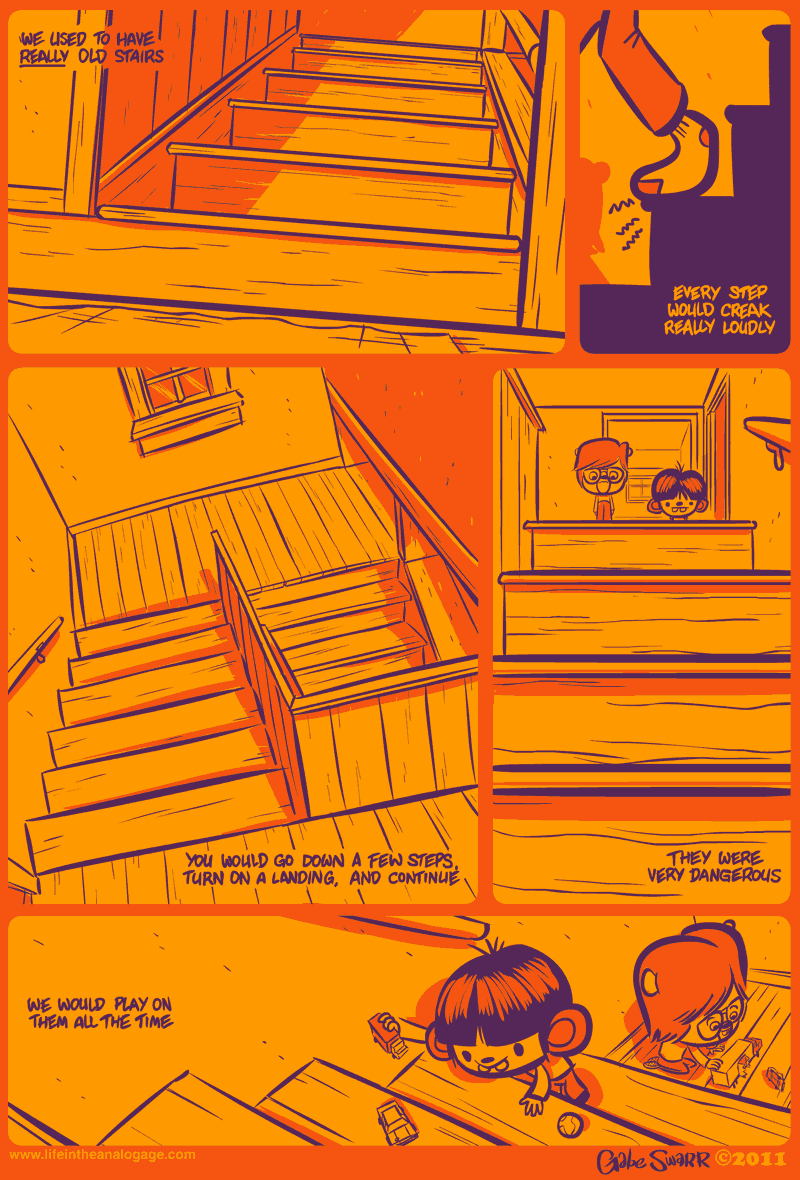 Comics are amazing things, aren’t they? You can have men in the underwear beating each other up one minute, and a highly personal coming of age story about a anthropomorphic rodent the next. Life in the Analog Age is the latter. Whilte it’s not exactly clear what animal Gabe Swarr sees himself as, what is clear is that he has a poetic love for the medium that translates into something that manages to be heartfelt and visceral without ever getting anywhere near saccharine. The book (and webcomic, and website) are a reflection on coming to age from Gabe’s perspective set predominantly in his early years, but, there’s a sense that he’s piecing together his life as an adult to find a throughline or logic to it. Like the best autobiographical comics, Gabe comes off as a real person, not an idealized, overly awesome (or awful) dream person. He’s flawed, but in the same way we all are.
Comics are amazing things, aren’t they? You can have men in the underwear beating each other up one minute, and a highly personal coming of age story about a anthropomorphic rodent the next. Life in the Analog Age is the latter. Whilte it’s not exactly clear what animal Gabe Swarr sees himself as, what is clear is that he has a poetic love for the medium that translates into something that manages to be heartfelt and visceral without ever getting anywhere near saccharine. The book (and webcomic, and website) are a reflection on coming to age from Gabe’s perspective set predominantly in his early years, but, there’s a sense that he’s piecing together his life as an adult to find a throughline or logic to it. Like the best autobiographical comics, Gabe comes off as a real person, not an idealized, overly awesome (or awful) dream person. He’s flawed, but in the same way we all are.
Swarr’s genius lays both in the design and layout of the stories, with his bold color choices, simple but elegant designs clearly influenced by his years in animation and in the earnestness with which he tells his stories. If just being awesome at making comics wasn’t enough, the webcomic form of the strip also includes animated shorts and an active discussion thread with every strip, that Swarr spends time on each day.
You can check out the webcomic version here. A print collection of the strips including some never before seen material is due out in September. Check the website for more info, or come meet Gabe in person at the Los Angeles Comic Con!
As will hopefully be the usual, I got a chance to talk with Gabe about his book. That conversation is below.
Joshua Hale Fialkov: So, obviously, you've drawn all your life. When were you first seduced by comics? What was the first one you saw, and what was the first one you drew?
Gabe Swarr: Well, my Dad bought a giant box of old comics for my brother and I when I was a round 10. It was filled with a ton of old comics, mostly Marvel and DC from the 60-70s. That's when I really was exposed to comics. It was like an education in a box. I really loved Marvel, the characters seemed way more real to me than DC.
The first comic I drew was in high school. It was actually supposed to be a collaboration with my friend but he ended up backing out at the last minute and I had to finish it myself. I sold it to friends and family for 2 bucks. It was pretty bad, actually really bad.
 JHF: You work predominantly in animation, right? Talk a bit about why you'd moonlight in the comics business?
JHF: You work predominantly in animation, right? Talk a bit about why you'd moonlight in the comics business?
GS: I do, I am a producer/director at Nickelodeon, but I've always loved comics. When I decided to go to school, I decided to go the Joe Kubert School of Cartoon and Graphic Art In New Jersey. The way the school worked was the first year was all basic drawing and techniques, then the second year you could choose to "major in" comics or animation. It was always the way to get to animation, but I still loved that first year. So for me, both comics and animation go hand in hand. One of the main reasons I moonlight in comics is because I love to tell stories and comics by far is a way faster and easier way to do that than animation. I also like the fact that I can do all kinds things I can't do in my day job.
JHF: Anybody who makes comics very quickly learns that it's all about the love and not about the money, how's that been coming for you?
GS: Oh, I've known that from the beginning. It's like that for indy animation too. I do love to dream though.
JHF: I'd love to hear your thoughts on what the difference creatively between animation and comics is and what you can do in each medium that separates it from the other.
GS: Well, I really think they are very similar actually. Each one has it's own strengths and weaknesses, but both of them are very cinematic to me. I always try to approach both in that manner. The main difference is that comics just don't move, so the reader has way more control over the experience than a viewer on animation. But that's also a good thing. They are more active and less passive, but to me, animation is way more immersive. You have timing, motion and music, but you also have to burden of that labor involved with all of those aspects.
Comics you don't have that burden, but you do have the burden to try to control the reader's eye. Pluses and minuses for each.
JHF: Have you thought about the transition from self publishing/web publishing and going with a more traditional publisher?
GS: I'd love to have my work published. I am currently doing web publishing because right now Analog Age isn't just comics, it's also about the culture, the community, and the animation. One of the big advantages of the web is that you instant feedback. You instantaneously see what people like or gravitate towards. You can grow much faster with less risk. You do have to give most of it away for free though…
Joshua Hale Fialkov is the Eisner, Harvey, and Emmy Award nominated writer and co-creator of the comic ELK’S RUN, TUMOR, ECHOES, and PUNKS THE COMIC. He highly recommends that you pre-order your comics, unless you are just happy being the problem and not part of the solution. You can find more about him at www.thefialkov.com.


I like the orange, but I’m interested to know why Gabe went with an orange tone.